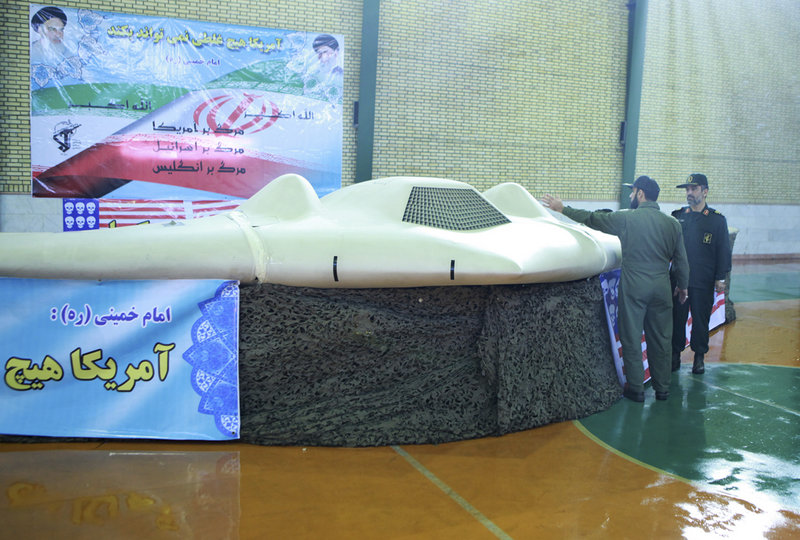WASHINGTON – The loss to Iran of the CIA’s surveillance drone bristling with advanced spy technology is more than a propaganda coup and intelligence windfall for the Tehran government. The plane’s capture has peeled back another layer of secrecy from expanding U.S. operations against Iran’s nuclear and military programs.
Just as the Soviet Union’s downing of the American U-2 spy plane revealed a hidden aspect of the Cold War, Iran’s recovery of the drone has shed light on the espionage that is part of U.S.-Iran hostilities.
Iran has charged the U.S. or its allies with waging a campaign of cyberwarfare and sabotage, and of assassinating some Iranian scientists. The U.S. has accused the Iranian government of helping kill U.S. troops in Afghanistan and plotting to murder the Saudi ambassador in Washington.
“It’s beginning to look like there’s a thinly veiled, increasingly violent, global cloak-and-dagger game afoot,” Thomas Donnelly, a former government official and military expert with the American Enterprise Institute, said at a Washington conference.
The covert operations in play are “much bigger than people appreciate,” said Stephen Hadley, former national security adviser under President George W. Bush. “But the U.S. needs to be using everything it can.”
Hadley said that if Iran continues to defy U.N. resolutions and doesn’t curb its nuclear ambitions, the quiet conflict “will only get nastier.”
Some historians and foreign policy experts compared the drone incident to the Soviet Union’s 1960 downing of the U-2 spy plane and pilot Francis Gary Powers. While those two countries sparred publicly on many issues, the world only occasionally glimpsed each side’s secret operations.
“When I first heard about the drone, my first thought was thank goodness there wasn’t a pilot in it,” said Francis Gary Powers Jr., the U-2 pilot’s son and founder of the Cold War Museum.
“They were both on intelligence-gathering missions. They were both doing photo reconnaissance. They were both supporting the U.S. government’s intelligence-gathering to find out intelligence about our adversaries,” Powers said.
The difference this time, Powers said, was that “there are no family members that have to be notified, there’s no prisoner in a foreign country.”
The U-2 downing shocked U.S. military planners, who thought the advanced aircraft flew too high to be hit by a Soviet missile. Likewise, Iran says it used advanced electronic warfare measures to detect, hack and bring down an RQ-170 Sentinel drone.
Iran aired TV footage Thursday of what current and former U.S. officials confirm is the missing Sentinel. The robotic aircraft suffered what appeared to be only minimal damage.
Iran protested Friday to the United Nations about what it called “provocative and covert operations” by the U.S. The Tehran government called the flight by the drone an “unprovoked air violation” that was “tantamount to an act of hostility.”
American officials said Friday that U.S. intelligence assessments indicate that Iran played no role in the downing, either by shooting it down or by using electronic or cybertechnology to force it from the sky. They contended the drone malfunctioned. The officials spoke on condition of anonymity in order to discuss the classified program.
Some U.S. experts voiced skepticism that Iran would be capable of such hacking. But others said Iran’s capacity to counter drones may have been bolstered by Russia’s decision, announced in October, to sell Tehran an advanced truck-mounted electronic intelligence system.
The RQ-170 is stealthy but not infallible, said robotics expert Peter Singer of Washington’s Brookings Institution think tank.
Singer, who has written extensively about drones, noted Russia’s announcement about the sale of an undisclosed number of truck-mounted electronic intelligence systems, called the IL-222 Avtobaza, to Tehran.
He said the equipment included “really good electronic warfare gear,” citing reports that its radars were designed to detect drones and included other equipment intended to intercept their data communications.
No country has demonstrated that it can seize control of a spy drone remotely, said Theodore Karasik, a security expert at the Dubai-based Institute for Near East and Gulf Military Analysis.
But if any could, Karasik said, the likely candidates would include China and Russia, which has conducted research on the subject. Karasik said either country might have aided Iran against the U.S.
The stealth drone is especially useful to the U.S. because it provides what is called “persistent surveillance” of Iran’s nuclear sites.
The U.S. and its allies suspect Iran is building a nuclear weapons complex under cover of a civilian program, a charge that Tehran adamantly denies.
Experts said the drone probably carried an advanced radar system as well as other specialized sensors, including detectors for monitoring nuclear sites. If those were reverse-engineered by Iran, they could give insights into how to hide its nuclear facilities from the U.S. surveillance.
Copy the Story Link
Send questions/comments to the editors.



Success. Please wait for the page to reload. If the page does not reload within 5 seconds, please refresh the page.
Enter your email and password to access comments.
Hi, to comment on stories you must . This profile is in addition to your subscription and website login.
Already have a commenting profile? .
Invalid username/password.
Please check your email to confirm and complete your registration.
Only subscribers are eligible to post comments. Please subscribe or login first for digital access. Here’s why.
Use the form below to reset your password. When you've submitted your account email, we will send an email with a reset code.